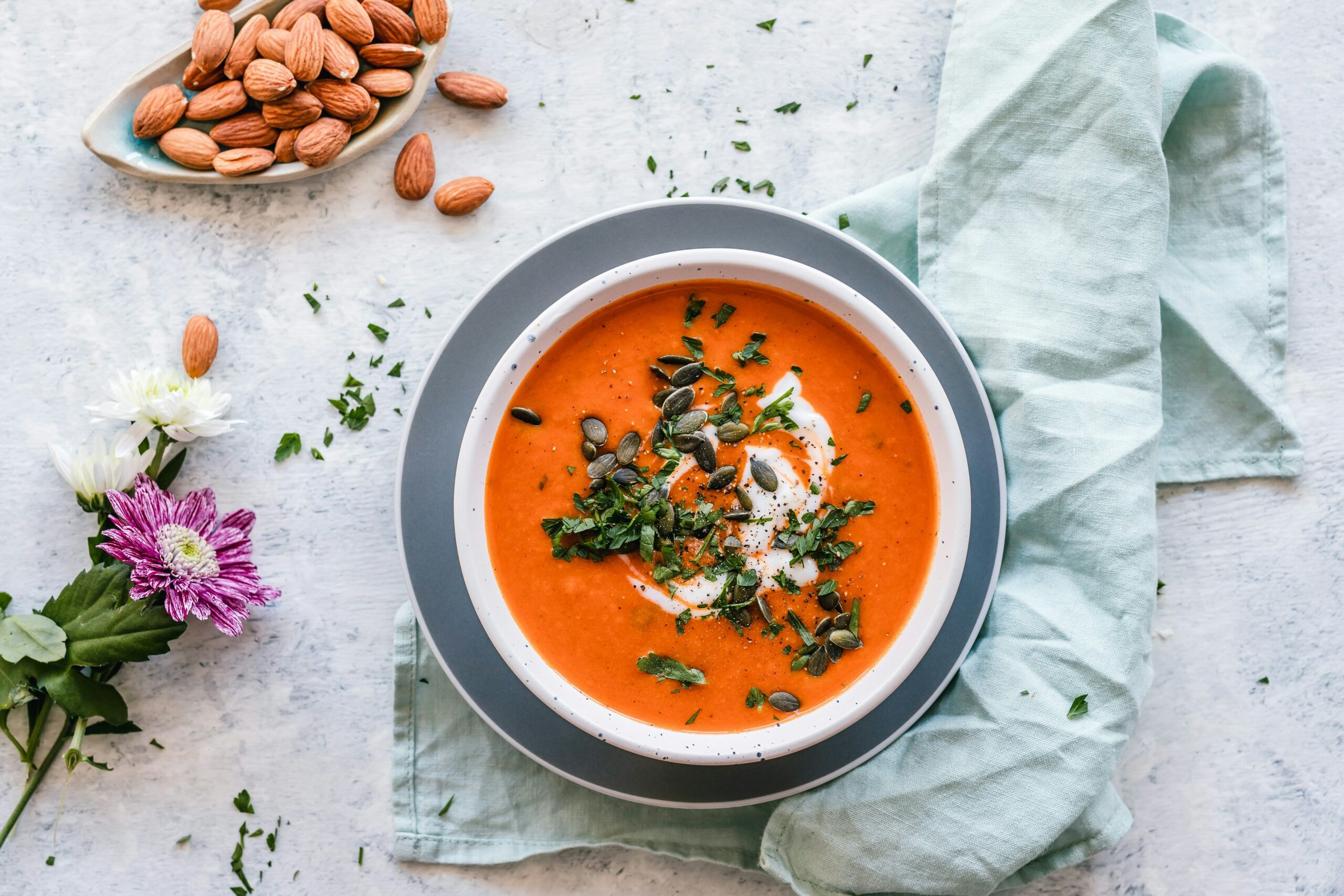If you need a recipe before you can make a pot of soup, this article is for you! No-Recipe Soup is so easy to make that sometimes I wonder why soup recipes are needed at all. Plus, learning to cook without using a recipe builds resilience and self-sufficiency. Follow these steps to create nourishing no-recipe soups from your pantry staples, even in unexpected circumstances.

If there’s one skill you really should practice and master, it’s cooking without using a recipe! Have you noticed how often professional chefs do this in cooking competition TV shows? That’s because they know what flavors go well together and which ingredients add texture and nutrition and then produce an amazing result. The easiest way for you to get started is with a pot of soup! Read on to learn a simple way to do this. Anyone can make no-recipe soup!
Even without a recipe, you can create delicious and nutritious soups for your family.
To be fair, there are varieties of soup and variations of soup that call for specific ingredients in specific quantities, but if you want a big ole pot of hot soup, especially on a chilly evening, there’s truly no need to Google “soup recipes”! You only need to browse through your fridge and cupboards to come up with your own creation. Pioneers did it this way, and you can, too!
Why soup?
Have you ever thought about soup as being one of the most economical, simple, and filling meals you can prepare? I’d be very surprised if you couldn’t come up with a No-Recipe Soup right this very minute.
Any and every soup contains two or more of these five basic categories of ingredients:
- A soup base
- Protein
- Produce
- Seasonings
- Grains/starches
That’s all there is to it, and with that combination in mind, you can invent literally hundreds of soups yourself. For penny-pinchers, nothing beats soup because there needn’t be any expensive ingredients and, even better, every ingredient is shelf-stable.
Create a Soup Without a Recipe
Step 1 – Start with the soup base
In the soup base category, invest in a few #2.5 cans of bouillon. I recommend these larger sizes over the tiny jars of bouillon and bouillon cubes at the grocery store. Also, humidity can turn a pile of bouillon into a solid mass as hard as a stone, so a #2.5 can will provide plenty of bouillon for many batches of soup but not so much (as in a #10 can) that the bouillon hardens before it can be used up in a reasonable amount of time.
You’ll use this bouillon for any soup that is broth-based and usually, bouillon comes in chicken, beef, and vegetable flavors. Some companies sell soup “stock”, which is just a richer flavored bouillon. If you make your own stock, by all means use that for the freshest flavor and nutrients you won’t get with store-bought bouillon.
Of course, not all soups start with a broth base. You may be in the mood for a rich, creamy chowder or cream-of-something soup. In that case, you’ll want to start with a cream base. If you have fresh cream, milk, or half-and-half, fill the pot with as much of the liquid as you need for your soup/chowder. From your food storage pantry, you can use dried milk. I double the amount of dried milk when I reconstitute it for soup or chowder, and you would never know that fresh milk hadn’t been used. I’ve also used powdered sour cream combined with dried milk for a different flavor.
The last category of soup bases is the tomato base. You’re in luck if you have tomato powder on hand. Acidic tomato sauce and tomato paste in cans have a shelf life of 12-18 months or so, which isn’t bad if you’ll be rotating them in with your everyday cooking, but tomato powder is the better bet when it comes to long-term storage. Combine tomato powder with dried milk for a cream of tomato base. Yumm!
Step 2 – Add protein for more nutrients
The addition of protein can be beans or legumes (very budget-friendly), canned/freeze-dried/fresh meat/chicken, or TVP (Textured Vegetable Protein). A little protein goes a long way in a soup, and many options are suitable for long-term storage. Combine some rice with beans in your soup recipe and you have a complete protein combination. Just switching out chicken for a cup or so of black beans will change the flavor and texture of your soup, and voila! You have a new soup recipe!
Your soup’s cooking time will depend, in part, upon which type of protein you’re using. Freeze-dried chicken, for example, will take just 5 or 6 minutes to rehydrate in the hot broth — this is perfect for quick meals. Dried beans and legumes take longer and you’ll need to keep an eye on the soup so the liquid doesn’t boil down before the beans, in particular, are tender and ready to eat.
Step 3 – Produce adds nutrients and fiber
The type of produce and amount you use in your batch of no-recipe soup are completely up to you. Personally, I love to melt a bit of butter in my soup pot and cook chopped onion and celery until both are tender. This step is easy but adds a richer flavor to the finished dish.
If you’re adding several different veggies to your soup, you’ll probably need less than a cup of each variety. Fresh is great, but soups are where dehydrated and freeze-dried produce really shine. They rehydrate and cook through far more quickly than fresh produce while retaining nearly all the same nutrients. When you use freeze-dried and/or dehydrated veggies in soup, remember they will absorb some of the liquid, so expect to add a little more milk or water, as the case may be. If you want to experiment with freeze-dried food, here is more about the food storage companies I recommend and why.
#10 cans of mushrooms, bell peppers, carrots, potatoes, onions, celery, green onions, and more are easy to store for several months, even after the can is open. Soup/stew blends are also handy because they combine several different veggies that are typically combined in many different recipes.
It usually doesn’t take much of any one ingredient for a soup to be a success, and the beauty of this step is that there are no hard and fast rules when it comes to combining ingredients.
Step 4 – Seasonings for Variety
Depending on how it’s seasoned, black bean soup can have a Cajun, Mexican, or hearty ham flavor. Stock up on a healthy supply of herbs, spices, and other seasonings so you can add variety at a moment’s notice. Go easy with your salt, pepper, herbs, and spices at first and give your soup the taste test. You can always add more of any one seasoning, but it’s really hard to backtrack if you’ve been a little too heavy-handed.
Step 5 – Grains/starches add fiber, calories, and nutrients
Those buckets of wheat contain a grain that adds flavor, texture, vitamins, and more when they’re cooked up in a soup. Yes, cooked wheat, or wheat berries, is a very healthy addition to soups, and this makes it wonderfully versatile. Barley, quinoa, and white or brown rice are inexpensive additions, adding calories and bulk for filling up tummies. Add, perhaps, a quarter cup or so of your selected grain. If you overdo this ingredient, the grain will absorb so much water that you may end up with a casserole instead of a soup!
Add a handful of macaroni or any other small pasta for yet another version of your No-Recipe Soup! Inexpensive and filling, small pasta is a great way to extend your soup if you discover you need to serve 8 people rather than 3 or 4.
Potatoes in just about any form are yet another inexpensive and versatile soup ingredient. A few scoops of leftover mashed potatoes are just right for finishing off a creamy leek soup or turning a cream-based soup into a thick, hearty chowder. Dehydrated potato dice are inexpensive, and a little goes a long way. Use the information and comparison chart here to help you decide which types of potatoes you want to use and store.
Tips for No-Recipe Soup Success
- At first, you may have to just “eye it” in order to know how much liquid you need for the number of people you’re serving.
- You can adjust the amount of “stuff” you put into your soup according to whether you want or prefer a soup with more or less liquid.
- Adjust the simmer time of your soup according to the density of the vegetables you’re adding. For example, fresh cauliflower will take a lot more time to become tender than fresh mushrooms or freeze-dried bell peppers.
- If you make a soup that is to die for, be sure to jot down the ingredients and quantities that you used, so you can replicate it, exactly, another time. Did your No-Recipe Soup turn out kind of meh? No need to put anything in writing! Just give it another try, with a different combination of ingredients on another day!
- If a #10 can is more economical than the smaller size, just scoop out as much bouillon as you think you’ll use within 2 or 3 months and seal the rest in a canning jar or Food Saver bag. Read this post for how to decide what size food storage can is right for you.
Related Food Storage Content
Get your Freeze-Dried Food Primer now!
Final Thoughts
Bottom line? You really don’t need a recipe for making soup! Add a little something from two or more of these categories, heat it, and give it a taste test! You know better than anyone which ingredients your family likes best and what you have in your pantry and refrigerator. Soup is really the perfect survival food, and there’s no reason not to enjoy a different variety of No-Recipe Soup every day!



















